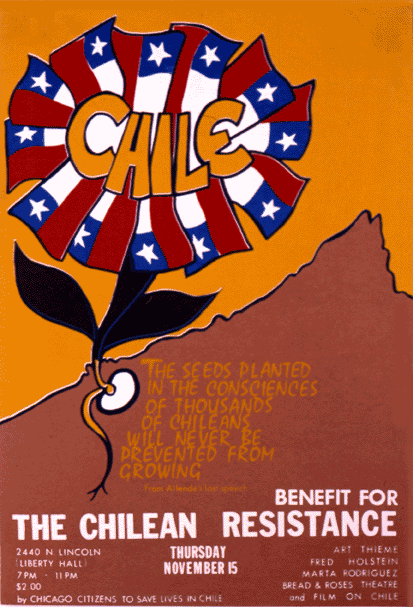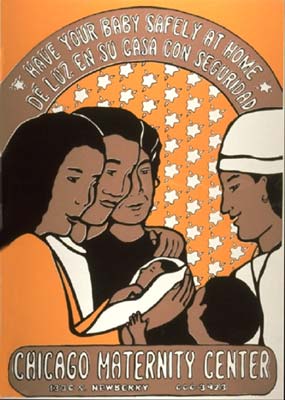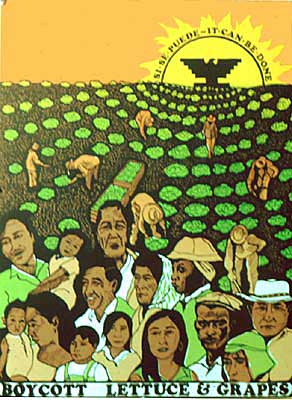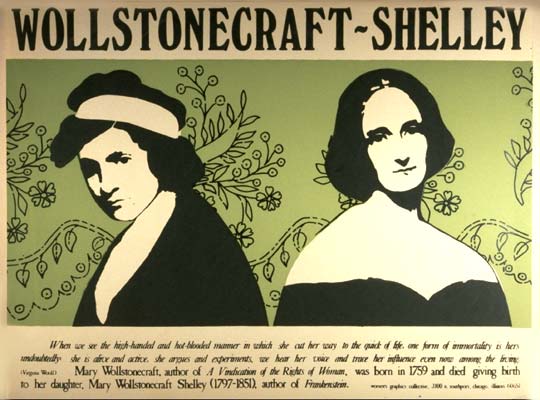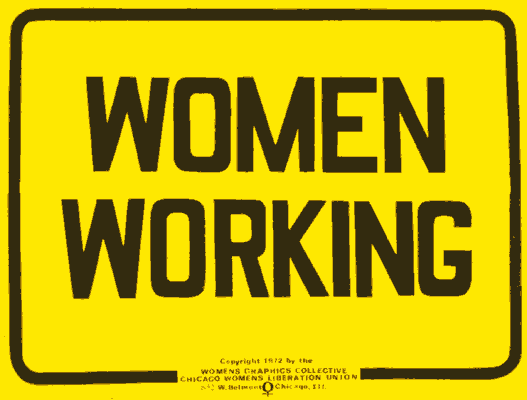The Chicago Women's Graphics Collective, much like the Chicago Women's Liberation Union and its Rock Band, is one of those neglected facets of the feminist movement in the 1970's. That is beginning to change with the release of films like She's Beautiful When She's Angry, as well as a broader interest being shown by a younger generation of feminists in their roots and history. The Graphics Collective created stunning work, some of which has found itself into the most well known iconographic annals of "the Long Sixties," even if its creators are far too infrequently acknowledged.
The text below is from Estelle Carol, a founding member of the CWGC. Still a feminist and socialist, she is now one half of the political cartoon duo Carol-Simpson, as well as a web designer in suburban Chicago. She also helps maintain the CWLU Herstory Project. Though Carol's words are her own, credit for the art remains with the Collective, an example of what happens when like-minded women, radicals, artists, come together for a common revolutionary and aesthetic purpose. – The Editors
* * *
In 1973, we worked in an old run down second floor office on Belmont Ave that we shared with the main offices of the Chicago Women’s Liberation Union. They call it New Town now, but in 1973, there wasn’t much new about it. We weren’t the only artists in the building though. Downstairs was a tattoo parlor.
Still it was better than having the studio located in my apartment on Newport Street where there were silkscreen tables in the dining room and a bathroom that doubled as a darkroom. My bedroom door opened directly into the dining room and usually reeked of the foul chemicals we used to make the posters. Just one OSHA inspection would have shut us down forever, but it was not until later that we learned about the dangers of long term exposure. On Newport Street, the Ravenswood L train was right next to the apartment and shook it like the aftershock of a California earthquake. But we were in the midst of a women’s revolution and our priorities were clear.
If you look at our posters you’ll rarely see a person’s name on it because we decided that modern art had been done all wrong by men. It was based on egotism and the cult of the individual – the "great men of art" syndrome. So we decided to throw all that out, and art now had to be a collective experience. So every poster that we created had to be done by committee. Every one.
Click for larger image
We had a system where any member of the Collective would get a subject area or an idea, or a phrase or an image and decide to do a poster. They would ask two or three members of the collective to be their assistants and to help develop the idea. And then in little teams they would physically create the poster in silk screen.
And it had to be a collective process. There’s no way that one single woman could really do it because we were using very primitive reproduction methods and in silk screening we needed at least three people to run the silk screen. The silk screened ones were all hand printed. No machines.
If a poster was more than one color, it had to be hand-printed for as many kinds of colors as we had, so it was very, very labor intensive. And we could only print at a maximum, two hundred at a time because that totally taxed our physical strength and our space. Eventually so many orders came in that we actually made a some money from the sale of them. We were then able to hire Salsedo Press, our favorite worker owned printshop, to offset print in larger quantities.
It was a very important part of the CWLU in general and helped give the organization a national presence. We were socialist feminists. Making women "equal" to men in an exploitative capitalist society was not our goal. So besides the clearly feminist posters, we did posters about healthcare, the Third World, labor and other issues. It gave people a lot of good feelings about what they were doing, and all the other work groups looked forward to the next poster coming out. The posters gave the CWLU a credibility, a presence and an image. I guess you’d call it marketing today, but back then that was a dirty word.
We had a a distribution network that was fairly extensive. We shipped them out to organizations, political bookstores and women’s groups all over the world, sometimes as many as 20,000 posters. Some of them were physically really big, so when people put them up on walls, they were hard to miss.
Of course collective art had its high points and its low points. We’d have these "Grumpy Sessions" where we’d get our gripes out in the open. When we were feeling positive about each other other we’d call it giving each other "warm fuzzies". When we were feeling negative toward one another, we’d call it giving each other "cold pricklies". I know it sounds like ridiculous psychobabble, but somehow visualizing our interactions helped to get us through a lot of the inevitable conflicts. In a story that Linda Winer of the Chicago Tribune did about us, Tibby, who was one of the most active members, said,"Criticism is so much easier to take when the poster is not one person’s creation." She was right.
It’s been a while, but I still remember some of the women from the Belmont Ave days. Tibby was my best friend then. She gave me the emotional Prozac I needed when I was too wound up, which was often. She would always tell me, "Estelle, never tell people 'You need to' ,'You ought to', or 'You should '." I tended to be very outer directed and task oriented. Okay, I was very bossy, but I tried to do it in a sweet way. I like to think I was successful most of the time.
Wendy was also my roommate and taught me yoga. She was very nice, but her earnest efforts to turn me into a lesbian ended in abysmal failure. Susan had come from Jane, the underground illegal abortion group. She had faced a possible 110 years in prison because of her abortion activities. After the charges were dropped, I guess she really needed to do something different. Barbara was the serious one under the big floppy hippie hats that she wore more or less constantly. Actually we were all a bunch of hippie artists. Except for Leslie. Leslie had a real apartment, with real furniture, a real husband, and a real kid. She also had real talent. Leslie did some of our most beautiful posters, like the Maternity Center one and the Farmworkers poster.
Of the posters I directed, my all time favorite is "Sisterhood is Blooming". This was a very common feeling at the time, because it expressed the love we tried to feel for one another and to some extent, actually did. I think it was this attitude that was undermined towards the middle of the 1970’s. And when this kind of attitude was undermined, that’s when a lot of the women’s movement began to fall apart.
Sisterhood is powerful, but sisters do fight. We didn’t know how to fight and have that make us come out stronger rather than weaker. Many of us were getting real power for the first time and we didn’t always handle it well. People were very suspicious of leaders, probably because they thought leaders would just reproduce the same old sick male power structure, only with women in charge. We had tensions over sexual orientation, race, and social class. We had honest, but often bitter divisions over political strategies. Considering the odds against us, I think we did pretty well keeping things together as long as we did.
We eventually moved out of the Belmont Ave building and into an old corner store on Southport Ave, with a full kitchen in the back. It was a much a bigger space and had the advantage of a wonderful German bakery across the street. We didn’t obsess about diets back then. Things were ok for a while, but by 1975, I was feeling very uncomfortable in the group.
The people who had started the Collective with me had largely moved on. We had always tried to reflect the diversity of the women’s movement, but the newer people coming in seemed to have a narrower focus. I felt an uncomfortable pressure on me because I was not a separatist. Female separatism had become a growing force in the women's movement and the Graphics Collective was no exception. Meetings became tense. Except for one woman who had a visceral dislike for me, nobody trashed me or anything like that, but it was clear that my socialist feminist vision was now in a minority of one.
I was physically exhausted from the sheer effort required in silkscreening and I had begun to fear that the chemicals we used might be damaging my health. Leaving the Graphics Collective was one of the most painful and wrenching experiences of my life, but I did it.
The Collective continued until 1983 and did some stunning posters that are among my most treasured possessions.
Today I am a graphic artist, a cartoonist and an illustrator. I love doing work for the labor movement and for various non-profit human service groups. I illustrate children’s books and work on a magazine for gay parents. About a year ago I decided that the history of the women’s liberation movement in Chicago needed to be shared with a new generation and I helped organize the Chicago Women’s Herstory Project. I taught myself enough about the Internet to become the site designer.
I want to communicate the excitement of that period so that young women today have a foundation upon which to wage the struggles they need to wage. I am hopeful that a new women’s liberation movement will arise to finish the job that we worked so hard on, and if it does, I have every intention of becoming a part of it. And if the movement wants some new posters...
Chicago Women's Graphics Collective operated from 1973 to 1983, and produced thousands of posters of a radical, socialist and feminist nature. More can be learned about them at the CWLU Herstory Project.












